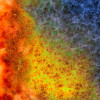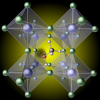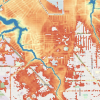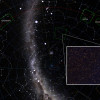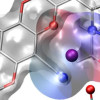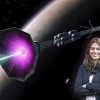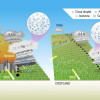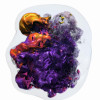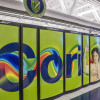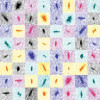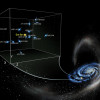Science News
Fire and Ice: How Arctic Sea Ice Influences Western U.S. Wildfires
New research from Pacific Northwest National Laboratory describes how climate conditions in one part of the world can, over time, influence climate outcomes thousands of kilometers away. Simulations run on Cori helped confirm this link Read More »
Perlmutter-Powered Deep-Learning Model Speeds Extreme Weather Predictions
Researchers from Berkeley Lab, Caltech, and NVIDIA trained the Fourier Neural Operator deep learning model to emulate atmospheric dynamics and provide high-fidelity extreme weather predictions across the globe a full five days in advance. Read More »
NERSC Targets Exascale with Perlmutter and the Exascale Science Applications Program
With an eye toward the first generation of exascale computing, in 2021 NERSC unveiled its newest supercomputer, Perlmutter. To ensure that users can readily utilize this next-generation technology, NERSC has been working with development teams to prepare codes for Perlmutter and the coming exascale systems through NESAP. Read More »
NERSC Resources Power Advances in Solar Cell Efficiency
The steady improvement in silicon-based solar cells has made them cost competitive with fossil fuel sources, and additional advances in their efficiency will make them even more attractive. New materials such as hybrid perovskites are poised to give solar-cell efficiency a boost, and research being conducted at NERSC is helping to pick up the pace. Read More »
Project Jupyter: A Computer Code that Transformed Science
As Project Jupyter becomes an increasingly important tool for data science, HPC sites around the world are responding to the demand by looking for ways to effectively support them. And NERSC has been at the forefront of this effort. Read More »
Study of Harvey Flooding Aids in Quantifying Climate Change
How much do the effects of climate change contribute to extreme weather events? A new study investigated the question for one particular element of one significant storm: Hurricane Harvey. Read More »
Limit global warming to 1.5°C and halve the land ice contribution to sea level this century
A new study predicts that sea-level rise could be halved this century (from today to 2100) if we meet the Paris Agreement target of limiting global warming to 1.5°C. This work combines nearly 900 simulations, including some of Berkeley Lab Computational Scientist Dan Martin's BISICLES models of Antarctic ice sheets. Read More »
NERSC and ESnet Take Scientific Data Collaboration to the Next Level
When the Dark Energy Science Collaboration needed a fast, secure, and convenient way to share large data sets with scientists outside of the collaboration, they turned to Berkeley Lab Computing Sciences for help, ultimately choosing an innovative data-sharing solution: the Modern Research Data Portal. Read More »
Designing Selective Membranes for Batteries Using a Drug Discovery Toolbox
Researchers have designed a polymer membrane with molecular cages built into its pores that could allow high-voltage battery cells to operate at higher power and more efficiently, important factors for both electric vehicles and aircraft. Read More »
NERSC Aids PPPL in Plasma Rocket Breakthrough
A revolutionary new rocket engine design has come out of Princeton University, with an assist from the National Energy Research Scientific Computing Center (NERSC) at Lawrence Berkeley National Laboratory. Read More »
How Urbanization and Pollution Increase Storm Activity Around Cities
Using NERSC’s Cori system, PNNL researchers modeled the effects of urban land and aerosols on storm patterns in two major U.S. cities. Read More »
HPC Explorations of Supernova Explosions Help Physicists Reach New Milestones
For more than 60 years, physicists have been studying the question of how supernova explosions occur. Thanks to the increasing power of supercomputing resources such as those at NERSC, they’re moving ever closer to an answer. Read More »
Superfacility Model Brings COVID Research Into Real Time
Researchers at NERSC and the Linac Coherent Light Source at SLAC are collaborating to leverage the superfacility model for real-time data analysis in the worldwide quest to decipher the SARS-CoV-2 virus. Read More »
Novel Data Processing Technique Aids XFEL Protein Structure Analysis
Scientists use X-ray crystallography to determine the three-dimensional structures of proteins. A new data processing approach is enhancing the outcomes. Read More »
Measurements of Pulsar Accelerations Reveal Milky Way’s Dark Side
It is well known that the expansion of the universe is accelerating due to a mysterious dark energy. Within galaxies, stars also experience an acceleration, though this is due to some combination of dark matter and stellar density. Researchers using NERSC supercomputers have obtained the first direct measurement of the average acceleration taking place within our home galaxy, the Milky Way. Read More »








